- Italy Tours Home
- Italy Ethos
- Tours 2023
- Blog
- Contact Us
- Dolomites
- Top 10 Dolomites
- Veneto
- Dolomites Geology
- Dolomiti Bellunesi
- Cortina
- Cadore
- Belluno
- Cansiglio
- Carso
- Carnia
- Sauris
- Friuli
- Trentino
- Ethnographic Museums
- Monte Baldo
- South Tyrol
- Alta Pusteria
- Dobbiaco
- Emilia-Romagna
- Aosta Valley
- Cinque Terre
- Portofino
- Northern Apennines
- Southern Apennines
- Italian Botanical Gardens
- Padua Botanical Garden
- Orchids of Italy
Ferrara Botanical Garden: One of the Historic Botanic Gardens in Italy.
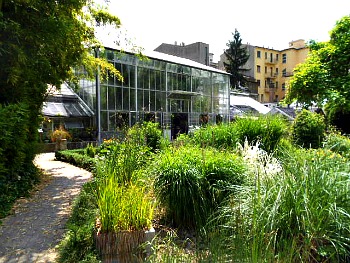
General History of the Garden
The Ferrara Botanical Garden can be counted among the most notable historic institutions of its kind in Italy.
In 1771, with the promulgation of a new reform chart, the University of Ferrara had the possibility to establish a Botanical Garden – known at the time as ‘Giardino dei Semplici’. Although the date of the official institution of the garden is later than that of other well-known horti of the same kind (such as those in Pisa, Padova and Bologna), one should not think that, because of this, botanic research had languished in Ferrara up to then. In fact, a University was active in Ferrara since 1391, which in no time, thanks to the presence of the Estensi – the family who ran the city – became one of the most renowned cultural centres in Italy.
During the Renaissance, the Estensi promoted all kinds of studies, including botanical research, which at the time was comprised within the medical sciences. That favoured the arrival in Ferrara of doctors who also dealt with botany, amongst whom are to be remembered Berengario da Carpi, Leoniceno and Mainardo. Great importance also had Antonio Musa Brasavola – an illustrious medic and plant connoisseur – Gabriele Fallopio and Gian Battista Canani. In such a cultured situation, so conducive to the study of botany, certainly there existed places devoted to the cultivation of medicinal species and other herbs of medical interest. Unfortunately, however, nothing remains pertaining the historical documentation related to the presence of a Botanical Garden – where it could have been located or indeed its very existence.
But the betterment of the general situation of the time, due to the reforms of Popes Clemente XIV and Pio VI, actually started a process which was to lead to the institution of a Botanical Garden in Ferrara, originally located in the gardens at via Paradiso, besides the ancient Palazzo Paradiso, seat of the University.
In 1772 a catalogue was finally published, including 2800 taxa – of both indigenous and exotic plants – supervised by the then Prefect of the Garden, Francesco Maria Giacomini. After that, at the beginning of the 1800s, the Ferrara Botanical Garden went into the capable hands of Antonio Campana, whose work was carried on by Francesco Jachelli and his son.
Since the end of the 1800s and until 1919, the direction of Ferrara Botanical Garden was given to Professor Carlo Massalongo, an eminent scholar who, however, could not prevent the transfer of the Garden from via Paradiso to via Scandiana – in a completely unsuitable site, as it was lamented by Professor Eugenio Baroni, to whom the direction of the Garden was entrusted from 1922 to 1929.
Only in 1925 was Ferrara Botanical Garden moved back to its original site, and there it remained until 1963 – year in which it was finally transferred to the grounds of the 16th century-built Palazzo Turchi-Di Bagno, where it still is (the picture at the top of the page shows the entrance to the gardens – the site is small but well-packed with plants – with the main glasshouses to one side; in the image below the other, minor glasshouses with specific collections can be seen facing directly opposite).
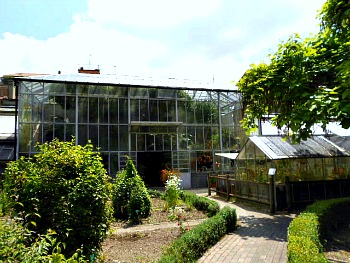
At the moment, the collections of Ferrara Botanical Garden are subdivided into 5 thematic sections and 36 sectors, which are succinctly described below (it is impossible to give a lengthy description of each sector here; for this, it is advised to check the University of Ferrara website or buy their publications. The list that follows is simply intended in support to the visit):
– Plants and beds ordered according to a systematic criterion: Bripohytes and Pteridophytes (Ferns and Equisetum sp.); Gymnosperms (Conifers and Ginkgo biloba); Tree Angiosperms (broadleaved trees); Primitive Dicotyledons (from waterlilies to magnolias); Monodicotyledons (from Calamus sp. to cereals); Evolved Dicotyledons (from Ranunculus sp. to sunflowers);
– Plants collected according to the criterion of utility for man or animals: Garden-orchard (trees and shrubs with edible fruits); Plants for the industry (oil, fabric and dye production); Aromatic plants (spices, essences, aromas for the food and cosmetic industry); Medicinal plants (herbs, shrubs and trees for medicinal use);
– Small thematic gardens: Rock Garden (bulbous species and mountain plants of European or extra-European origin); Shady corner (sector with herbaceous plants and shade-loving climbers); Mediterranean Garden (sector with Mediterranean plants, autochthonous and exotic); Hygrophytes’ corner (sector with plants from fresh and humid terrains); Water Garden (pond with water-loving and sun-loving species from freshwater habitats); Officinal plants’ corner (sector with officinal herbs, trees and shrubs, sometimes also poisonous); English Garden (irregular beds with natural hedges, ancient rose varieties and other ornamental species); Low Peat-bog (pond with plants from wetlands or marshes typical of the plains); Italian Garden (geometric beds with evergreen hedges, blossoming plants and Citrus fruits); Tea Garden (Roji: a Japanese tea-garden dating to the 16th century);
– Species protected by Regional or National Laws: Protected species from humid, shaded and arid habitats; Protected species from water habitats (sun-loving and water-loving plants);
– Tropical and Subtropical plants: Exotic Ferns (epiphytes; tree-ferns and tropical ferns); Exotic Gymnosperms (Cycads, Podocarpus sp. and other similar species); Exotic water-loving plants (tropical and sub-tropical sun-loving and water-loving species); Sensitive plants (Mimosa pudica and other species similarly sensitive to mechanical stimuli); Cacti (succulent plants from desert habitats worldwide); Epiphyte plants (Bromeliads and other species that grow on trees); Epiphyte succulents (Cacti and other similar species growing on trees); Officinal exotic plants (edible, medicinal, aromatic and poisonous species of extra-European origin); Epiphyte orchids (exotic orchids from forest habitats worldwide); Western exotic plants (species from the tropical regions of Africa and America); Eastern exotic plants (species from the tropical regions of Asia and Oceania); Carnivorous plants (species that feed on small insects; see picture of the glasshouse below); Bananas (Musa sapientum and other Musa species); Palm bed (Trachycarpus fortunei and other Arecaceae).
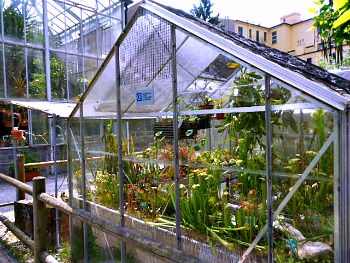
Visit of the Garden
The five sections presented above are scattered throughout the garden and mixed; it is therefore not possible to follow them regularly when planning a visit route. However – even though packed full of plants – the site is relatively small, so that an approximate description of the route can be presented here.
At the entrance of the gardens, to the left, are the main glasshouses, containing most of the Tropical and Subtropical plants (see the two pictures above). Inside these are the Cacti collections, and most of the other sectors found in the Tropical and Sub-tropical section (an image of the succulents’ collections is presented below).
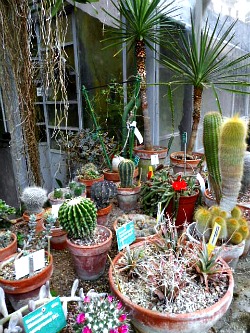
On the other side, facing right opposite the main glasshouses are a few smaller glasshouses hosting more specific collections that require a particular micro-climate and conditions, such as the carnivorous plants (pictured two images above) or those species coming from desert habitats. An example is given in the picture below, which displays a beautiful specimen of Euphorbia coerulescens – a typical desert cactus. The following image shows the interior of the desert glasshouse.
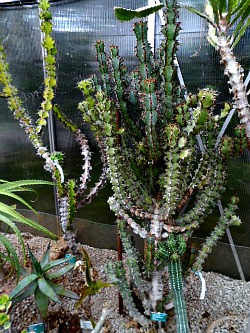
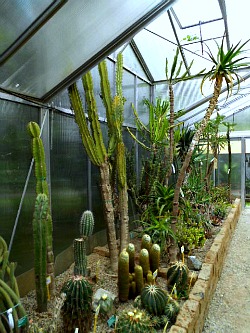
The garden then develops mostly to the right of the glasshouses, in a square plot. The Ferrara Botanical Garden is in fact right at the heart of the 16th century expansion of the city (the so-called Addizione Erculea), and some of the monumental buildings of this area are visible on the background of the picture shown below; the renowned Palazzo dei Diamanti is literally two minutes’ walk away.
Inside this section, the first areas to be encountered are the beds that contain useful plants (aromatic and medicinal; see image below).
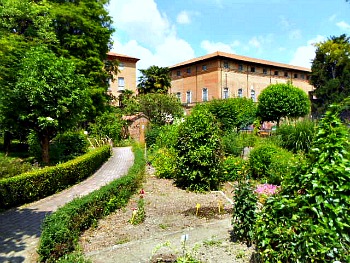
Proceeding further, one encounters the pond area, reproducing wetland habitats, where most hygrophilous (water-loving) plants can be found (see picture below).
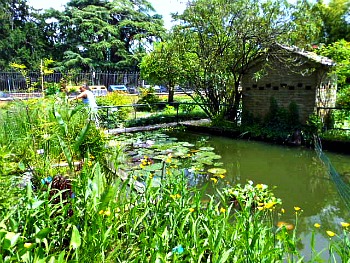
Further still, one reaches the corner where the administration offices and other services are located (that is, at the other end of the garden). In this part of Ferrara Botanical Garden are taken out the tropical and sub-tropical plants that can stay outdoors during the summer months; there is also an old specimen of a beautiful climber, Campsis radicans, which grows against the wall of the service building.
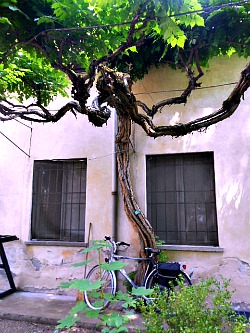
Turning back from this building now, in the closing image below is a view on the palms’ collection, which is only taken out for the summer; the Corso Porta Mare – where the entrance to Ferrara Botanical Garden is – runs just beside. On the other side of the road is another historic garden, Giardino Massari, with several old trees; two majestic specimens of Cedrus atlantica can just be glimpsed in the picture.
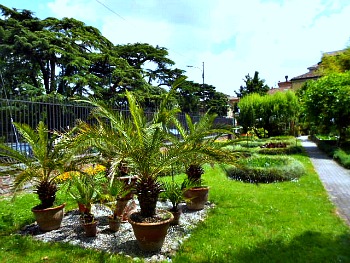
Return from Ferrara Botanical Garden to Emilia-Romagna
Copyright © 2019 Italy-Tours-in-Nature

New! Comments
Have your say about what you just read! Leave me a comment in the box below.